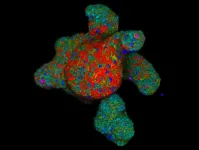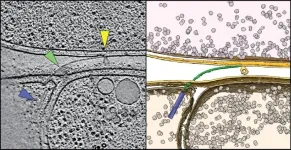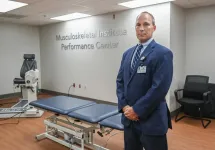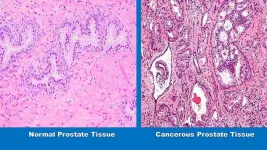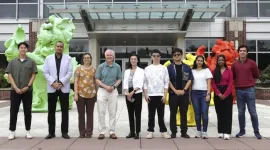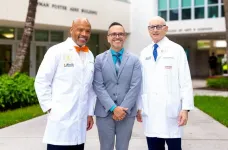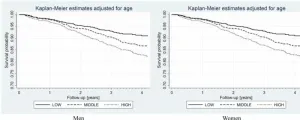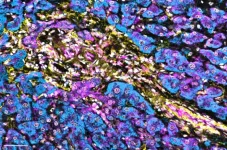Extratropical forest fire emissions are increasing as climate changes
2024-10-17
As climate change promotes fire-favorable weather, climate-driven wildfires in extratropical forests have overtaken tropical forests as the leading source of global fire emissions, researchers report. The findings raise urgent concerns about the future of forest carbon sinks under climate change. Fire has long played a role in shaping Earth's forests and regulating carbon storage in ecosystems. However, anthropogenic climate change has intensified fire-prone weather, leading to an increase in burned areas and carbon emissions, particularly in forested regions. These fires not only reduce forests' ability to absorb carbon but also disrupt ecosystems, harm biodiversity, and pose significant ...
A new approach to capturing complex mixtures of organic chemicals in blood, evaluated in pregnant women
2024-10-17
Studies of chemicals in our blood typically capture only a small and unknown fraction of the entire chemical universe. Now, a new approach aims to change that. In a study involving blood samples of pregnant women collected between 2006 and 2008, researchers report having quantified many complex mixtures of chemicals that may pose neurotoxic risks, even when the individual chemicals were present at seemingly harmless levels. “The quantification of 294 to 473 chemicals in plasma is a major improvement compared with the usual targeted analysis focusing on only few selective analytes,” wrote the authors. ...
Gut instincts: Intestinal nutrient sensors
2024-10-17
A multi-institutional group of researchers led by the Hubrecht Institute and Roche’s Institute of Human Biology has developed strategies to identify regulators of intestinal hormone secretion. In response to incoming food, these hormones are secreted by rare hormone producing cells in the gut and play key roles in managing digestion and appetite. The team has developed new tools to identify potential ‘nutrient sensors’ on these hormone producing cells and study their function. This could result in new strategies to interfere with the release of these hormones and provide avenues for the treatment of a variety of metabolic or gut motility disorders. The work will be presented ...
Catching prey with grappling hooks and cannons
2024-10-17
Countless bacteria call the vastness of the oceans home, and they all face the same problem: the nutrients they need to grow and multiply are scarce and unevenly distributed in the waters around them. In some spots they are present in abundance, but in many places they are sorely lacking. This has led a few bacteria to develop into efficient hunters to tap into new sources of sustenance in the form of other microorganisms.
Although this strategy is very successful, researchers have so far found only a few predatory bacterial species. One is the soil bacterium Myxococcus xanthus; ...
Effects of chemical mixtures: Neurotoxic effects add up
2024-10-17
"In our everyday lives, we are exposed to a wide variety of chemicals that are distributed and accumulate in our bodies. These are highly complex mixtures that can affect bodily functions and our health," says Prof Beate Escher, Head of the UFZ Department of Cell Toxicology and Professor at the University of Tübingen. "It is known from environmental and water studies that the effects of chemicals add up when they occur in low concentrations in complex mixtures. Whether this is also the case in the human body has not yet been sufficiently investigated - this is precisely where our study comes in."
The extensive research work was based on over 600 blood samples from ...
Mpox in Africa was neglected during the previous outbreak, and requires urgent action and investment by leaders now to prevent global spread
2024-10-17
Mpox in Africa was neglected during the previous outbreak, and requires urgent action and investment by leaders now to prevent global spread, claim experts from The Independent Panel for Pandemic Preparedness and Response, ex-NZ Prime Minister Helen Clark, former Liberian President and Nobel Peace Prize winner Ellen Johnson Sirleaf, and other global health specialists.
####
Article URL: https://journals.plos.org/globalpublichealth/article?id=10.1371/journal.pgph.0003714
Article Title: Mpox: Neglect has led to a more dangerous virus now spreading across borders, harming and killing people. Leaders must take action to stop mpox now
Author Countries: ...
A new era of treating neurological diseases at the blood-brain-immune interface
2024-10-17
SAN FRANCISCO—The question of what causes complex neurological diseases such as Alzheimer’s or multiple sclerosis continues to confound scientists and doctors, with the unknowns standing in the way of early diagnoses and effective treatments.
Even among identical twins who share the same genetic risk factors, one may develop a particular neurological disease while the other does not.
That’s because unlike diseases such as cystic fibrosis or sickle-cell anemia, which are caused by a single gene, most neurological disorders are associated with many—sometimes hundreds—of rare genetic variants. ...
Astronomers detect ancient lonely quasars with murky origins
2024-10-17
A quasar is the extremely bright core of a galaxy that hosts an active supermassive black hole at its center. As the black hole draws in surrounding gas and dust, it blasts out an enormous amount of energy, making quasars some of the brightest objects in the universe. Quasars have been observed as early as a few hundred million years after the Big Bang, and it’s been a mystery as to how these objects could have grown so bright and massive in such a short amount of cosmic time.
Scientists have proposed that the earliest quasars sprang from overly dense ...
New study highlights the dangers of handheld cellphone use among teen drivers
2024-10-17
PHILADELPHIA (October 17, 2024) – A new study, conducted by a group of researchers led by Penn Nursing and Perelman School of Medicine and funded by the Centers for Disease Control, found a strong association between handheld cellphone use and risky driving behaviors among newly licensed teen drivers. The study, published online first in JAMA Open, used a smartphone telematics application to track the driving habits of hundreds of teens and identify potential safety risks.
The investigation found that teens who used their cellphones while driving were significantly more likely to engage in risky driving behaviors, such as hard braking and rapid acceleration. These behaviors can ...
Part of the GBHSH community in Spain uses doxycycline to prevent sexually transmitted diseases
2024-10-17
The increasing incidence of sexually transmitted bacterial infections (STIs) is a major public health problem worldwide. Currently, among the therapies being studied is the use of the antibiotic doxycycline as a method of post-exposure prophylaxis after unprotected sex — known as DoxyPEP. Now, the University of Barcelona and the NGO Stop have carried out the first study in Spain on the use of DoxyPEP as a preventive strategy among the gay, bisexual and other men who have sex with men (GBHSH) community in Spain.
“The results suggest that, although medical and scientific associations rarely endorse the community use of DoxyPEP as a prevention strategy, ...
Researchers at Wake Forest University School of Medicine receive $4.5 million grant from Department of Defense to study neck injuries
2024-10-17
CHARLOTTE, N.C. – Oct. 17, 2024 – Researchers at Wake Forest University School of Medicine have received a three-year, $4.5 million grant from the Department of Defense to study cervical spine injuries in military personnel.
Musculoskeletal injuries, such as those that occur to the cervical spine (neck), are problematic for military personnel. This is especially true for military personnel who must perform missions in demanding environments with head-supported mass. This head-supported mass includes the baseline protective helmet, communications, specialized night vision technology and other attachments.
“These injuries can lead to a significant number of lost-duty ...
Study suggests a healthy diet may help keep low grade prostate cancer from progressing to more dangerous states during active surveillance
2024-10-17
In a peer-reviewed study believed to be the first of its kind published, a research team led by Johns Hopkins Medicine provides scientific evidence that a healthy diet may reduce the chance of low risk prostate cancer progressing to a more aggressive state in men undergoing active surveillance — a clinical option in which men with lower risk cancer are carefully monitored for progression in lieu of treatments that could have undesired side effects or complications.
The findings are reported today in the journal JAMA Oncology.
“Many men diagnosed with low grade prostate cancer are interested in changes they can ...
Center for Genomic Diagnostics receives first USDA grant
2024-10-17
Foreign animal diseases are a global threat to swine production with the potential for detrimental economic implications. Recently, researchers at the University of Illinois Urbana-Champaign received a three-year grant of $650,000 from the U.S. Department of Agriculture to develop sensitive, rapid, low-cost, and portable point-of-use biosensors to improve on-farm detection and surveillance of African swine fever virus.
ASFV is a large DNA virus that infects swine and can result in a lethal hemorrhagic fever, spread rapidly to neighboring pigs, and cause excessive morbidity ...
The National Tax Journal is pleased to announce the recipients of the 2024 Musgrave Prize and the 2024 Referee Award
2024-10-17
The National Tax Journal is pleased to announce the recipients of the 2024 Musgrave Prize and the 2024 Referee Award.
The Richard A. Musgrave Prize was created in 1999 and is presented each year to the author(s) of the best article published in the National Tax Journal. The award is a tribute to Richard Musgrave, whose work throughout his luminous career was characterized by a powerful blend of analytical clarity, insight drawn from the historical record, and respect for the importance of administrative issues. With this award, the National Tax Association recognizes his many contributions to public policy theory, research, and practice.
This year, ...
Study finds legalization didn’t increase recreational cannabis use among young adults in country of Georgia
2024-10-17
(Boston)—Cannabis is one of the most widely used drugs, with an estimated 219 million users globally in 2021, with the highest number of users in the Americas. It is also the most used drug among young people. In the U.S., cannabis use among young adults (age 19 to 22) reached a historically high level in 2021, with 42.6% reporting use in the past year.
Effects and impact of recreational cannabis legalization and decriminalization on societies is a topic of global relevance and increasing scientific interest. Despite a rapidly growing body of published evidence, findings remain mostly ...
A.J. Drexel Autism Institute study highlights key challenges and opportunities in transitioning autistic individuals into adulthood
2024-10-17
The Autism Transitions Research Project, funded by the Health Resources and Services Administration and led by Drexel University’s A.J. Drexel Autism Institute, has released new findings that underscore critical challenges and opportunities in transitioning autistic youth into adulthood. As approximately 1.2 million autistic individuals are expected to reach adulthood in the coming decade, these insights are vital for shaping future research and services.
The study, “Challenges and Opportunities in Transitioning Autistic Individuals into Adulthood,” led by Anne M. Roux, a research scientist and director at the Policy Impact Project in the ...
Measuring defects to better understand quantum systems
2024-10-17
Quantum defects have the potential to act as ultra-sensitive sensors that could offer new kinds of navigation or biological sensor technology.
One type of these defect systems, nitrogen vacancy (NV) centers in diamonds, can measure nanoscale magnetic fields. But while scientists can control the quantum spin of these centers — single defects in the diamond, where nitrogen has replaced the carbon — they still do not have a full understanding of how to best isolate that spin from the spins of other defects in the material, which can destroy its quantum state memory, ...
Repurposing drug shows promise in fighting aggressive brain tumours: uOttawa study
2024-10-17
Glioblastoma is the most common – and the most malignant – primary brain tumour in adults. It’s aggressive and incurable. Even with treatment including surgical removal and chemotherapy, the median survival for patients is just 18 months.
Now, innovative new research led by Dr. Arezu Jahani-Asl, Canada Research Chair in Neurobiology of Disease at the University of Ottawa, provides highly compelling evidence that a drug used to slow the progression of the disease ALS shows promise ...
New initiative to fuel neuroscience and aging research
2024-10-17
Demonstrating its commitment to excellence as a member of the Association of American Universities and number one in the state for National Institutes of Health (NIH) funding, the University of Miami has pledged to invest more than $30 million to bolster basic science research that will target neuroscience and aging, some of the most complex conditions confronting the United States population, including in South Florida.
The investment over the next five years will create a new program in ...
WashU researchers use genetics to find psychopathology risks
2024-10-17
When trying to understand how genetic influences factor into youth behavior, researchers at Washington University in St. Louis have taken the “big trawl” approach, casting their net wide to pull in all the measured traits, behaviors and environments that make up who we are and examine associations with the genetic building blocks comprising risk for mental health problems.
This cutting-edge methodology has turned up valuable new insights into factors related to psychopathological genetic risk, ...
Fibroblast growth factor 21 and survival in the elderly: Polsenior2 study results
2024-10-17
“Of note, participants with high serum levels of FGF21 more frequently had metabolic complications, such as hypertension, obesity, diabetes, hypercholesterolemia, and hypertriglyceridemia.”
BUFFALO, NY- October 17, 2024 – A new research paper was published in Aging (listed by MEDLINE/PubMed as "Aging (Albany NY)" and "Aging-US" by Web of Science), Volume 16, Issue 19 on September 18, 2024, entitled, “Fibroblast growth factor 21 inversely correlates with survival in elderly population – the results of the Polsenior2 study.”
As ...
Plankton balloon to six times their size in newly discovered mode of oceanic travel
2024-10-17
Many plankton journey from the cold, dark depths of our oceans to the surface, only to eventually drift down again into the darkness in a perpetual rhythm. Yet, how single-celled phytoplankton, most of which have no appendages to help them swim, make this pilgrimage has remained a mystery. In a paper publishing October 17 in the Cell Press journal Current Biology, researchers describe a species of bioluminescent phytoplankton, called Pyrocystis noctiluca, that balloons to six times their original size of a few hundred microns. This massive inflation allows the plankton to journey up to 200 meters toward the ocean’s surface to capture sunlight, then ...
Repurposing drugs to eliminate cellular origins of brain tumors
2024-10-17
Glioblastomas are aggressive brain tumors with a median survival time of less than 22 months despite standard therapy including surgery, irradiation, and chemotherapy. It has become clear in recent years that not all cells within the brain tumor have an equal potential to divide and drive tumor growth. As such, a fraction of tumor cells called brain tumor stem cells (BTSCs) are thought to be the primary origin of tumor re-growth after surgery in addition to being resistant to standard treatments including chemotherapy and irradiation. Therefore, targeting BTSCs may be a way to effectively treat glioblastomas.
In an effort to rapidly identify ...
Biomarker may predict immunotherapy response in liver cancer
2024-10-17
It may soon be possible to determine which patients with a type of liver cancer called hepatocellular carcinoma would benefit from immunotherapy, according to a preclinical study by Weill Cornell Medicine investigators.
The study, published Oct. 17 in Molecular Cell, provides new insights into a pair of proteins, called p62 and NBR1, and their opposing functions in regulating the interferon response in hepatic stellate cells, a critical immune component in the liver’s fight against tumors. The study demonstrates that high levels of the immune-suppressing NBR1 in these specialized cells may identify patients who are unlikely to respond ...
Prevalence of glaucoma among US adults in 2022
2024-10-17
About The Study: This meta-analysis found that an estimated 2.56% of people 40 years or older have glaucoma, slightly more than estimated by previous studies. Black individuals are disproportionately affected. Prevalence estimates at the state and county level can help guide public health planning.
Corresponding Author: To contact the corresponding author, Joshua R. Ehrlich, MD, MPH, email joshre@umich.edu.
To access the embargoed study: Visit our For The Media website at this link https://media.jamanetwork.com/
(doi:10.1001/jamaophthalmol.2024.3884)
Editor’s ...
[1] ... [732]
[733]
[734]
[735]
[736]
[737]
[738]
[739]
740
[741]
[742]
[743]
[744]
[745]
[746]
[747]
[748]
... [8688]
Press-News.org - Free Press Release Distribution service.
